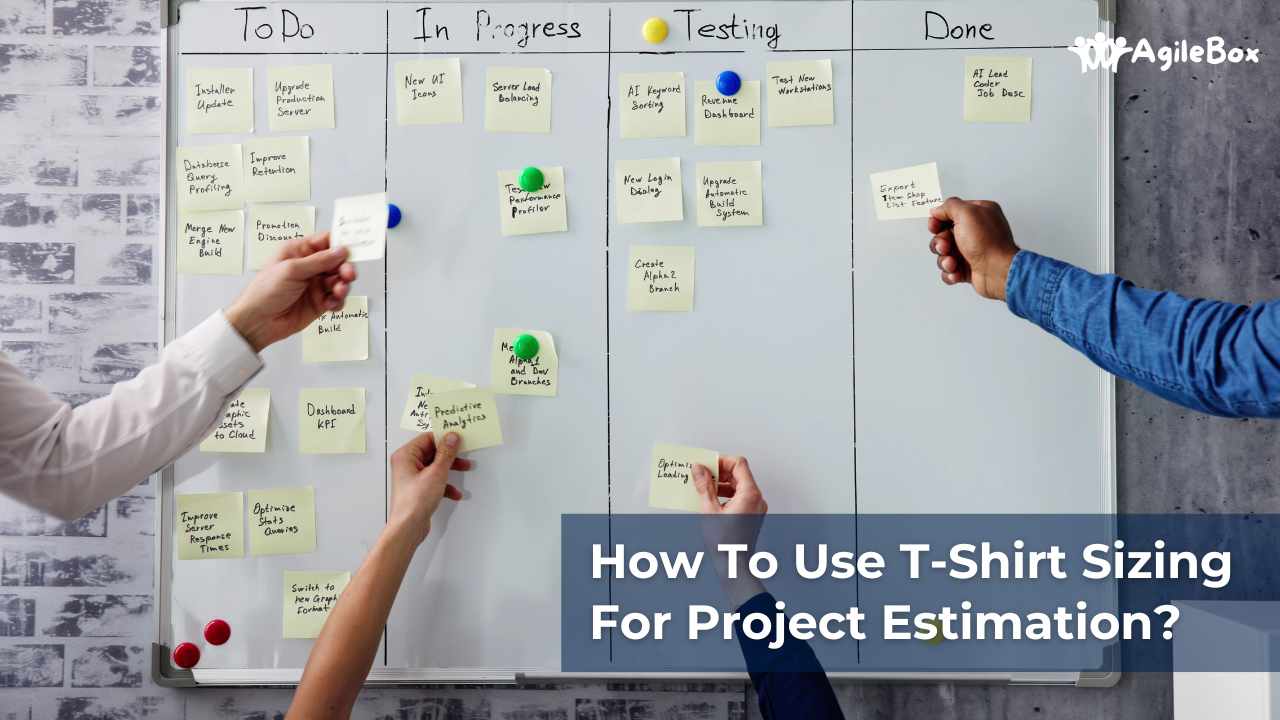One of the biggest challenges is accurately estimating the effort required for tasks. Traditional methods like hours or days can sometimes feel too rigid, especially when dealing with varying complexities across different initiatives. This is where t-shirt sizing comes into play.
T-shirt sizing provides a simpler, more flexible approach to estimating the effort or size of a task. Instead of focusing on time, it categorizes tasks based on their relative complexity or effort, using sizes such as small (S), medium (M), large (L), and extra-large (XL). This makes it easier for teams to quickly assess and compare tasks.
In this blog, we’ll explore what t-shirt sizing is, how to use it in Agile projects, and the key steps to implementing it effectively for project estimation.
What is T-Shirt Sizing?
T-shirt sizing is a relative estimation technique commonly used in Agile project management. Instead of trying to assign a specific number of hours or days to a task, teams use predefined size categories, such as small (S), medium (M), large (L), and extra-large (XL), to represent the effort required.
These categories offer a way to assess tasks based on their complexity, uncertainty, or resource demand. For example, a “small” task might require minimal effort and have a clear path to completion, while an “extra-large” task could indicate high complexity, greater risk, or the need for additional resources.
The interesting of t-shirt sizing lies in its simplicity. It allows teams to quickly and collaboratively make decisions about workload without getting bogged down in the details. Plus, it promotes conversations about task difficulty, leading to better alignment and understanding across the team.

How to Use T-Shirt Sizing for Agile Projects
In Agile projects, t-shirt sizing serves as an efficient tool for estimating and planning. It shifts the focus from exact time estimates to a more intuitive understanding of task complexity, which is particularly useful when there’s uncertainty or variation in how long a task may take.
Here’s how you can use t-shirt sizing in Agile:
1. Discuss Complexity, Not Time: Instead of diving into how many hours or days a task will take, teams discuss the relative complexity or effort required. A large-sized task might involve more unknowns or dependencies, while a small task could be a routine, straightforward one.
2. Collaborative Estimation: T-shirt sizing works best when the entire team participates. This encourages open discussions about the task’s requirements, risks, and possible roadblocks, ensuring that everyone is on the same page when it comes to the size assignment.
3. Prioritization Made Easier: By assigning t-shirt sizes, teams can prioritize tasks based on their size and allocate resources accordingly. Larger tasks might be broken down into smaller pieces, while smaller tasks can be scheduled for quicker wins.
4. Flexibility in Planning: Since t-shirt sizing avoids strict timelines, it offers flexibility when planning. Teams can adjust their sprint capacity, shuffle tasks, or handle unexpected changes more easily without the pressure of time-based estimates.
By using t-shirt sizing, Agile teams can streamline their planning process, reduce estimation debates, and create more realistic and manageable sprints.
Why Team Should Try Planning Poker?
6 Steps to Using T-Shirt Sizing for Project Estimation
Implementing t-shirt sizing in your project estimation process is straightforward. Follow these six steps to ensure consistency and accuracy:
1. Start by Deciding on Your Sizes
Begin by determining the size categories you’ll use. The most common approach is using small (S), medium (M), large (L), and extra-large (XL), but you can customize these to fit your team’s needs. Some teams may include additional sizes, like extra-small (XS) or double-extra-large (XXL), to add more nuance.
2. Align on What Each Size Represents
Next, ensure that your team has a shared understanding of what each size means. For example, an “S” task could represent a few hours of work with no dependencies, while an “XL” task might involve several team members, unknowns, and more than a week’s work. By aligning on definitions, you avoid confusion during the estimation process.
3. Decide Who Assigns T-Shirt Sizes
In some teams, the entire team participates in sizing discussions, while in others, a specific group or product owner may assign the sizes. Decide who will be responsible for this to streamline the process. Collaborative sizing is often preferred as it brings in different perspectives and ensures everyone is on the same page.
4. Assign T-Shirt Sizes to Each Initiative
Once you’ve agreed on the size categories and definitions, assign t-shirt sizes to each task or initiative in your backlog. This process can be done during sprint planning meetings or backlog refinement sessions, ensuring that each item has a clear, agreed-upon size before work begins.
5. Track T-Shirt Sizes Using a Work Management Tool
Use a tool to track the sizes of tasks in your project management software. Tools like Jira, Trello, or AgileBox allow you to easily tag tasks with t-shirt sizes and help in visualizing the effort across the sprint. Tracking sizes helps teams balance their workloads and ensure that large tasks are broken down if needed.
6. Use T-Shirt Sizing to Gauge Workload
Once all tasks are assigned a size, teams can use this information to gauge their overall workload. Smaller tasks can be slotted in to fill gaps, while larger tasks may need more time or resources. This holistic view helps ensure that sprints are neither overloaded nor underutilized.
T-Shirt Sizing Estimation Examples
Let’s look at a few examples to understand how t-shirt sizing can be applied in project estimation.
Example 1: A Simple Task (Small – S)
You’re asked to fix a minor bug in the code that’s already been identified and isolated. This task doesn’t have any dependencies, and you expect it to be resolved within a few hours. This is a clear Small (S) task—minimal effort, low risk, and quick turnaround.
Example 2: A Medium-Complexity Task (Medium – M)
A request comes in to create a new feature that requires collaboration between the design and development teams. While the task isn’t overly complex, it does involve some back-and-forth to get everything in place, and it could take a couple of days to complete. This would be a Medium (M) task—it involves more effort and coordination but is still manageable within a sprint.
Example 3: A Large Task with Dependencies (Large – L)
Now imagine a larger initiative: refactoring an entire section of your application to improve performance. This task involves multiple team members, several dependencies, and potential risks that need to be considered. It’s expected to take a week or more to complete. This would be sized as Large (L)—a bigger task with greater effort and complexity.
Example 4: An Ambitious Initiative (Extra-Large – XL)
For a more complex example, suppose your team is tasked with launching an entirely new product feature that integrates with external systems. There are many unknowns, including third-party dependencies, high risk, and cross-functional collaboration across teams. This is clearly an Extra-Large (XL) task, requiring significant planning and resources over a longer period.
These examples demonstrate how t-shirt sizing offers flexibility, making it easier for teams to gauge task complexity and allocate resources more effectively.
The Benefits of T-Shirt Sizing
“Now, let’s explore the benefits that make T-shirt sizing a valuable estimation technique for Agile teams:”
1. Simplifies the Estimation Process
By focusing on relative size rather than exact time or effort, t-shirt sizing simplifies what can often be a complicated process. Instead of debating over hours or days, teams quickly assign a size based on the perceived complexity of the task, speeding up estimation discussions.
2. Promotes Team Collaboration
T-shirt sizing encourages open communication and collaboration within the team. Since it relies on consensus, team members are motivated to share their insights, discuss task complexities, and align on the expected effort. This helps create a shared understanding and fosters better teamwork.
3. Increases Flexibility
One of the major strengths of t-shirt sizing is its flexibility. Because it’s not tied to rigid timeframes, it allows teams to adapt more easily to changing priorities or unexpected challenges. If something turns out to be larger than initially thought, it can be resized or broken down further without disrupting the entire sprint.
4. Helps Manage Uncertainty
T-shirt sizing is particularly helpful when tasks involve unknowns or risk. Instead of trying to force a precise estimate on something uncertain, teams can give it a larger size, acknowledging that more effort or time may be required. This helps in better managing uncertainty without over-promising or under-delivering.
5. Balances Workload
With tasks sized according to their complexity, teams can balance their workload more effectively. Large tasks may need to be split into smaller, more manageable pieces, while smaller tasks can be scheduled to fill gaps in the sprint. This ensures a more even distribution of effort across the team.
6. Supports Continuous Improvement
Over time, as teams get more familiar with t-shirt sizing, they can refine their sizing process. The more tasks they estimate and complete, the better their understanding of what each size entails, leading to continuous improvement in estimation accuracy.
With these benefits, t-shirt sizing becomes a powerful tool in the Agile project management toolkit, helping teams estimate more efficiently, manage workloads, and stay adaptable.
Conclusion
T-shirt sizing is a simple yet effective way to handle project estimation in Agile environments. By focusing on task complexity and effort rather than time, it allows teams to streamline their estimation process, improve collaboration, and remain flexible when dealing with uncertainty. The six-step approach helps teams standardize the process, making it easier to estimate tasks and manage workloads.
Whether you’re dealing with straightforward tasks or complex initiatives, t-shirt sizing offers a practical framework that scales with the needs of your project. As your team gains more experience with t-shirt sizing, you’ll see improvements in both accuracy and efficiency, enabling smoother sprints and better planning overall.
If you’re looking for a more intuitive way to estimate and plan your projects, give t-shirt sizing a try—it might be just what your team needs to enhance their workflow and deliver value more consistently.




